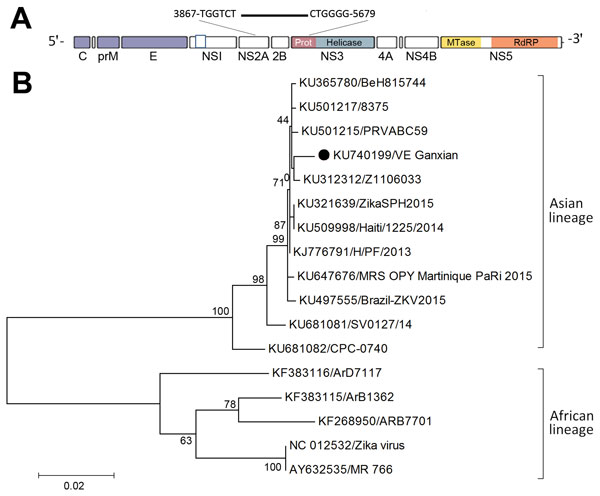Volume 22, Number 6—June 2016
Letter
Zika Virus in a Traveler Returning to China from Caracas, Venezuela, February 2016
Figure

Figure. Phylogenetic analysis of partial sequences of Zika virus for an imported case of Zika virus infection in a traveler returning to China from Caracas, Venezuela, February 2016, compared with selected other strains from GenBank. A) Schematic diagram showing the contiguous sequence, obtained from de novo assembly and BLAST (http://blast.ncbi.nlm.nih.gov/Blast.cgi), targeted at the 3′ terminus of nonstructural protein 2B and the 5′ terminus of nonstructural protein 3 genes (figure not drawn to scale). B) Maximum-likelihood phylogenetic tree inferred based on the Tamura-Nei model (8). The partial sequence of VE_Ganxian (black dot) obtained in this study was analyzed against 11 reference strains of Asian lineage and 5 reference strains of African lineage. All positions containing gaps and missing data were eliminated. Evolutionary analyses were conducted in MEGA version 7.0 (http://www.megasoftware.net). GenBank accession numbers are given. Scale bar indicates number of substitutions per site. C, capsid; E, envelope; MTase, methyltransferase; PrM, premembrane; RdRP, RNA-dependent RNA polymerase.
References
- Besnard M, Lastere S, Teissier A, Cao-Lormeau V, Musso D. Evidence of perinatal transmission of Zika virus, French Polynesia, December 2013 and February 2014. Euro Surveill. 2014;19:20751. DOIPubMedGoogle Scholar
- Musso D, Roche C, Robin E, Nhan T, Teissier A, Cao-Lormeau VM. Potential sexual transmission of Zika virus. Emerg Infect Dis. 2015;21:359–61. DOIPubMedGoogle Scholar
- Ioos S, Mallet HP, Leparc Goffart I, Gauthier V, Cardoso T, Herida M. Current Zika virus epidemiology and recent epidemics. Med Mal Infect. 2014;44:302–7. DOIPubMedGoogle Scholar
- Pan American Health Organization, World Health Organization. Epidemiological update: neurological syndrome, congenital anomalies, and Zika virus infection (17 January 2016) [cited 2016 Mar 7]. http://www.paho.org/hq/index.php?option=com_docman&task=doc_view&Itemid=270&gid=32879&lang=en
- Bogoch II, Brady OJ, Kraemer MU, German M, Creatore MI, Kulkarni MA, Anticipating the international spread of Zika virus from Brazil. Lancet. 2016;387:335–6. DOIPubMedGoogle Scholar
- Xu RM. Geographic distribution of Aedes aegypti and Aedes albopictus. In: Lu, ML, ed. Vector of dengue fever and its prevention and control in mainland China. Gui Zhou (China): Gui Zhou People’s Press; 1990. p. 51–55.
- Pang Z, Li A, Li J, Qu J, He C, Zhang S, Comprehensive multiplex one-step real-time TaqMan qRT-PCR assays for detection and quantification of hemorrhagic fever viruses. PLoS ONE. 2014;9:e95635. DOIPubMedGoogle Scholar
- Tamura K, Nei M. Estimation of the number of nucleotide substitutions in the control region of mitochondrial DNA in humans and chimpanzees. Mol Biol Evol. 1993;10:512–26 .PubMedGoogle Scholar
- Duffy MR, Chen TH, Hancock WT, Powers AM, Kool JL, Lanciotti RS, Zika virus outbreak on Yap Island, Federated States of Micronesia. N Engl J Med. 2009;360:2536–43. DOIPubMedGoogle Scholar
- Lu L, Lin H, Tian L, Yang W, Sun J, Liu Q. Time series analysis of dengue fever and weather in Guangzhou, China. BMC Public Health. 2009;9:395. DOIPubMedGoogle Scholar
1These authors contributed equally to this article.